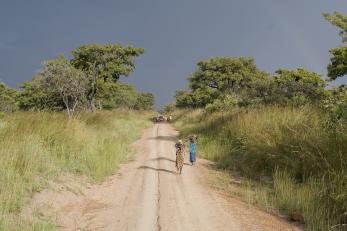Timeline: Northern Uganda Crisis

The struggle between the Ugandan military and the Lord's Resistance Army has raged for more than twenty years across northern Uganda. To put the length of the crisis into context, consider this: the current conflict took root in the same month — January 1986 — that the Space Shuttle Challenger exploded, killing its entire crew. President Ronald Reagan was less than halfway through his second term in office.
The war has killed tens of thousands and displaced more than 1.6 million people.
But how and why did it begin?
January 1986
After four years of political chaos, Yoweri Museveni's National Resistance Army overthrows the Acholi-led government that came to power after the fall of infamous dictator Idi Amin. Museveni's support is strongest in southwestern Uganda, which bore the brunt of the previous regime's alleged brutality that killed an estimated 300,000 civilians.
August 1986
An insurgency against now-President Museveni's army begins in traditional Acholi areas of northern Uganda. The people of northern Uganda are particularly concerned that Museveni's forces, comprised mostly of southern Ugandans, will seek retribution for the brutality of the Obote years.
January 1987
Joseph Kony, a 26-year-old northern Ugandan who claims to communicate with spirits, forms the Lord's Resistance Army (LRA) to fight the Ugandan army. Kony's stated goals are to first overthrow Museveni's government and then rule Uganda with a theocracy based on Kony's own interpretation of the Ten Commandments.
1987-1991
The LRA, under Kony's command, raids villages throughout northern Uganda to show the Ugandan army is unable to protect the populace; the LRA begins abducting civilians into military service.
March 1991
The Ugandan government launches "Operation North," arming local villages to combat the LRA; in retaliation, Kony massacres and mutilates suspected government supporters among the Acholi population.
1991-1994
The LRA insurgency grows and becomes more violent; families begin to flee their villages.
February 1994
After peace talks between the Ugandan government and LRA fail, Kony's LRA establishes bases in South Sudan.
1994-1996
LRA attacks escalate; abductions, especially of children and young people, increase.
April 1995
The Ugandan government breaks off diplomatic relations with Sudan, accusing the Sudanese government of supporting the LRA.
October 1996
More than 200 LRA rebels attack and raid St. Mary's College in the northern Ugandan town of Aboke, abducting 139 girls between the ages of 13 and 16. Many of these girls were given to LRA commanders as "wives" and many died in captivity. This incident was one of the first to bring LRA abductions to the attention of the international community.
Late 1996
The Ugandan government begins moving Acholi villagers into "protected villages" to shield them from LRA attacks; however, these displacement camps are overcrowded, unsanitary places susceptible to rebel incursions.
1996-2002
Thousands more families stream into displacement camps as the war continues unabated.
March 2002
The government's "Operation Iron Fist" against LRA forces in northern Uganda and South Sudan sparks a bloody counteroffensive by the LRA. Areas previously untouched by the conflict are now engulfed in the fighting, causing even more widespread displacement.
November 2003
The UN's top humanitarian official travels to northern Uganda and declares, "I cannot find any other part of the world that is having an emergency on the scale of Uganda, that is getting such little international attention."
December 2003>
President Museveni recommends that the International Criminal Court (ICC) investigate Kony and other LRA leaders for war crimes.
August 2005
Amid reports of escalating violence and a worsening humanitarian catastrophe, Mercy Corps dispatches an emergency response team to northern Uganda. Over the next few months, this team of veteran aid workers conducts assessments in poorly supplied camps and begins lifesaving relief programs for displaced families.
October 2005
The ICC issues arrest warrants - the first since its 2002 founding - for Joseph Kony and his top lieutenants. The warrants cite war crimes and crimes against humanity including murder, rape, sexual slavery and enlistment of children as combatants.
July 2006
Mercy Corps receives permission from Ugandan government to begin humanitarian operations in Pader District, where approximately 95 percent of the population has been forced from their homes. The first program focuses on agricultural recovery: Mercy Corps distributes seeds and tools to more than 8,800 people.
Peace talks begin between the LRA and Ugandan government in Juba, South Sudan.
September 2006
Both sides agree to a temporary ceasefire. The Ugandan government establishes "return camps" to begin returning families to their villages of origin. The LRA gathers its forces in South Sudan for the time being and no new attacks are reported.